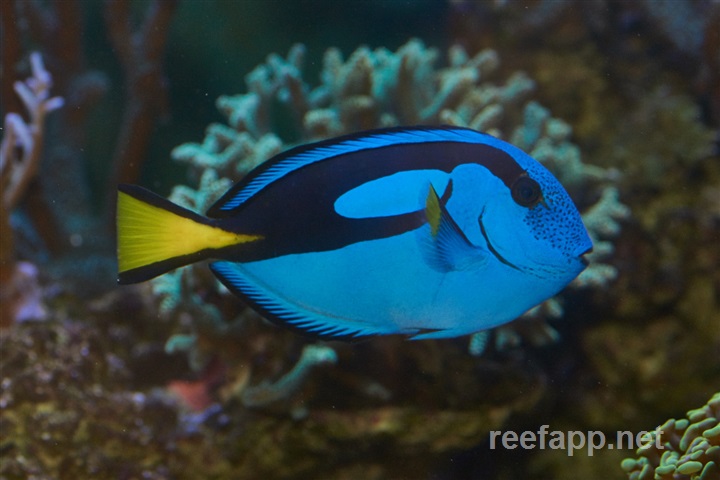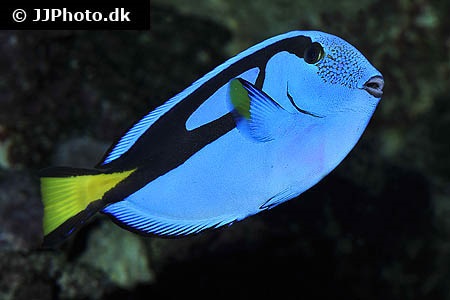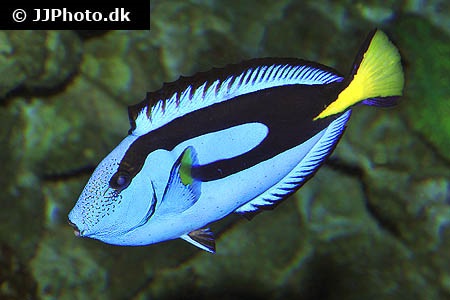Paracanthurus hepatus
| Latin name | Paracanthurus hepatus - (Linnaeus, 1766) |
|---|---|
| Local name | Blue Tang |
| Family | Acanthuridae - Paracanthurus |
| Origin | |
| Max length | 31 cm (12.2") |
| Minimum volume |
700 l (185 gal) |
|---|---|
| Hardiness |
Delicate |
| Suitable for aquarium |
Suitable with care |
| Reef safe |
Reef safe with caution |
| Aggressiveness | Peaceful |
| Recommended |
Macroalgea (Eg. seaweed / nori) Microalgea (Eg. spirulina) |
|---|---|
| Mostly |
Small crustaceans (Krill, mysis, artemia...) |
| Maybee |
Large polyp stone coral (LPS) Soft coral |
This species is easily susceptible to Marine Ich (Cryptocaryon irritants), when stressed by other fish, bad water quality, or when relocated.
This species is very sensitive during transportation and acclimatizing into the aquarium.
These fish should be kept in a well run aquarium where they can "graze" algae from rocks and stones.
If there are insufficient algae on the rocks, it is important to feed more frequently and supplement with algae rich food e.g. Spirulina.
This species often has a fun and interesting personality.
This species revels in swimming and requires an aquarium with ample space.
This species requires places to hide, especially when newly introduced into the aquarium.
Even though these fish enjoy a diverse type of frozen foods, it is imperative that its primary food, is algae based, thus ensuring that the fish`s immune system remains healthy.
This can, for example, be plant based fish flakes, Nori seaweed or similar.
There is also a variety with a yellow belly.
As these fish become bigger they may well be hard on Zoanthus and certain types of LPS.
This genus only has one species, but it is unique in relation to other Surgeonfish.
They are generally peaceful and ignored by many other species of Surgeonfish, since they do not resemble them. They are however delicate, especially during transportation. They should be placed in a peaceful environment with plenty to eat during acclimatization.
This surgeonfish has a charming way of swimming and can act almost playful when it is observed.
Because of this behaviour it is absolutely not, suited to small aquaria. It matures quickly and even though it seems that immature ones fit in the tank, it is not recommended.
Surgeonfish (Acanthuridae) live primarily of different types of algae, making it a popular choice for coral aquariums, as they help to keep the aquarium algae free.
Most Surgeonfish have a scalpel by the caudal fin, used to defend themselves. It can cause some deep lacerations, so pay attention if the fish start to fight and when handling the fish.
When in the aquarium, they will spend most of their time swimming around and nibbling the algae from the stones. Surgeonfish will rarely irritate corals or invertebrates. Large Palettes/Blue tangs can be an exception.
The Surgeonfish are not typically aggressive towards other types of fish. If more Surgeonfish are added to the aquarium, they will establish a hierarchy. It is best to add the most aggressive species last and to ensure that there are sufficient hiding places, as they prefer to have their own individual sleeping area.
If multiple aggressive species are added to the same aquarium, one runs the risk of one of them dying due to stress. One must therefore be cautious about adding multiple Acanthurus species or Zebrasoma xanthurum into the same aquarium. A combination of the different genera will normally get along well, although the more aggressive species can still be challenging.
| Aquarium trade | Yes |
|---|---|
| Distribution | Indo-Pacific: East Africa, including the Mascarene Islands (Ref. 37792) to Kiribati, north to southern Japan, south to the southern Great Barrier Reef, New Caledonia, and Samoa. |
| English common names |
Indo-pacific bluetang Palette surgeonfish |
| Danish common names |
Paletkirurgfisk |
Bob Fenner. Paracanthurus hepatus, the Pacific Blue Tang of Many Names - Wet Web Media - (English)
Henry C. Schultz. 2003. Identity Crisis – What’s My Name? Paracanthurus hepatus - Reefkeeping Magazine - (English)
2005. Fish of the Month: Paracanthurus hepatus - Tropical Fish Hobbyist - (English)
James W. Fatherree. 2009. Aquarium Fish: Surgeonfishes, A.K.A. the Tangs - Advanced Aquarist - (English)
Bob Fenner. Surgeons, Tangs and Doctorfishes, Family Acanthuridae - Wet Web Media - (English)
2013. Kirurgfisk - Saltvandswiki - (Danish)




